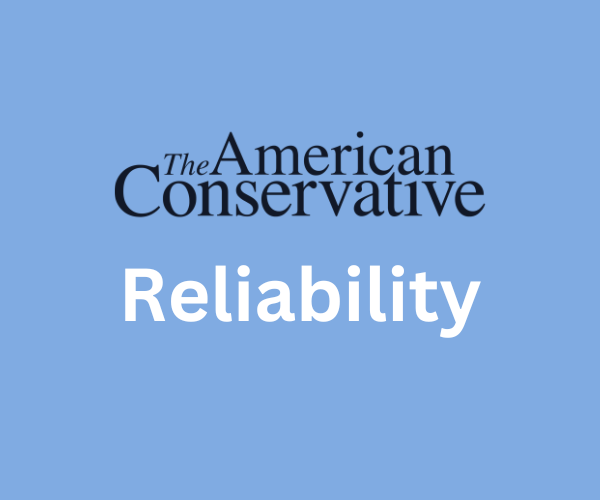
The American Conservative, a right-leaning news source, offers a variety of articles that often challenge the conventions of articles published by mainstream media. When these articles steer in a different direction, it may be the case that they are not as trustworthy or reliable as other articles. This warrants taking a closer look at The American Conservative and its reliability.
Biasly’s rating, based on the Analyst and A.I. ratings of different articles, for the reliability of The American Conservative is ‘Fair.’ This points to The American Conservative offering a moderate reliability. Although individual articles can differ, The American Conservative on average offers factual news that is supported by factual sources.
Does Reliability Matter?
Reliability, in general, refers to how trustworthy or accurate information, or in this case, a news source is. If we consider this definition, it quickly becomes clear why reliability is important in media sources. When a news source is unreliable and publishes misleading or factually incorrect articles, readers lose trust in the news and often become misinformed. This begs the question of how exactly we can gauge the reliability of a news source.
There are several potential measures of reliability to look out for when trying to determine whether a media source is reliable or not. Red flags for an unreliable article can include the presence of wild unsubstantiated claims, facts dependent on other unreliable sources, heavy use of opinionated language, and more. Some indicators of a reliable news source, on the other hand, include things like:
- Absence of subjective/opinionated language in articles
- Credible sources cited (e.g., neutral sources, .gov, .edu websites)
- Facts and statistics backed by multiple relevant outside sources
- Use of primary sources when possible (e.g., interviews, quotes)
- Information that remains consistent across news sources
So How Does The American Conservative Fare in its Reliability?
The political reliability index developed by Biasly objectively assesses news organizations’ accuracy and trustworthiness. The American Conservative’s overall Reliability Score has been rated as ‘Fair’ by Biasly. This rating is a weighted average of two distinct scores: the Fact Analysis Score and the Source Analysis Score, each evaluating separate components of The American Conservative’s Reliability. When computing the Average Reliability of the article the Fact Analysis score is more heavily weighted. These ratings are as follows in the next two paragraphs:
The American Conservative’s Fact Analysis Score is ‘Fair,’ which suggests readers can trust some of The American Conservative’s content online. The Fact Analysis score focuses more on the accuracy of claims, facts, and sources presented in the article and any hints of selection and omission bias, which we will discuss further in the article.
The American Conservative’s Source Analysis Score is ‘Fair,’ which suggests readers can trust some of the sources, links, and quotes provided by the news source. This score, which is based on A.I., focuses on assessing the quality of sources and quotes used including their number, lengths, uniqueness, and diversity.
However, since these scores are based on percentages and averages, individual articles could be more or less trustworthy depending on the context, author, and other factors.
Let us analyze the supporting data for The American Conservative’s rankings and discuss what to watch out for while searching for trustworthy news sources.
The American Conservative Accuracy and Reliability
The credibility of news organizations is significantly impacted by bias and political orientation. Like numerous other media organizations, The American Conservative has occasionally been accused of prioritizing the conservative agenda above facts. We can evaluate the integrity of The American Conservative’s news stories and deduce how well the publication supports assertions with evidence, and see whether this is indeed the case. We will check for selection and omission bias as we assess the articles’ correctness and factuality.
Selection bias is when stories and facts are selected, often on ideological grounds, to create a narrative in support of the new sources’ ideology. Omission bias, on the other hand, is when different opinions and political views regarding a situation are left out so that the reader is only exposed to the ideological perspective supported by the author. It’s important to keep in mind these two types of biases when trying to assess an article’s level of accuracy.
Biasly assigns a percentage score to accuracy, with one being the least accurate and 100 being the most. Ratings are calculated by weighing assertions with supporting evidence, the number of reliable internal sources, and the number of reliable external sources employed. A full page at Biasly’s website includes dependability and accuracy ratings for newly released The American Conservative news stories. As we previously stated, according to the reports analytics have assessed, The American Conservative has a Fair reliability score. This score can vary from article to article, though, and the most extreme variations in dependability are caused by bias, notably omission, and selection bias. Consider also CBS News, which has a “Medium Liberal” Bias and a “Good” analyst reliability score according to Biasly. For example, they published an article that had an 98% reliability score titled,” New study finds one-third of COVID survivors suffer mental health and neurological disorders,” and another article called, “Biden officials defend border response as number of migrant children in U.S. custody tops 20,000,” that had a 52% reliability score. As a result, stories displaying political leaning are less reliable than neutral ones.
For instance, The American Conservative article titled, “Sam Brown Wins Nevada Republican Primary” is rated as Somewhat Conservative. Concerning the selection and omission bias, the author, Spencer Neale, does a good job of quoting sources who support Brown’s campaign for Nevada Senator. However, Neale fails to offer any other viewpoints. He quotes Trump, who endorsed Brown by posting on Truth Social:
“Sam Brown is a FEARLESS AMERICAN PATRIOT, a Purple Heart Recipient, who has proven he has the ‘PURE GRIT’ and COURAGE to take on our Enemies, both Foreign and Domestic.”
This article portrays a moderately conservative stance, mostly due to portraying Brown, a pro-life Republican, as a good choice for Nevada senator. However, Neale fails to balance his viewpoints, and commentary while reporting on this campaign. If Neale had included someone who is not in favor of Brown’s campaign, he could provide a more holistic view of the Nevada Senate race. Therefore, this article can be considered mostly reliable.
We will take a closer look at more examples like this below, providing a further investigation into the reliability of The American Conservative’s articles. This will include its use of selection bias, omission bias, and the quality of its sources and facts used.
Analysis of Reliability in The American Conservative Opinion Pieces
Opinion-style journalism is a suitable venue for reporters to express their opinions and beliefs, as opposed to news articles where this is something to be avoided. Although opinion pieces are often less trustworthy due to their subjectivity, they can still be worthwhile to read to increase one’s understanding of various political viewpoints.
Quality of Sources and Facts Used
The American Conservative can be good at using reliable sources from both sides of the ideological divide and citing facts as evidence, however, this is not the case for every article. For instance, Jude Russo’s article “‘Waivable Loans for Ukraine Are Just Grants” uses one long quote, one medium quote, and one short quote. Longer quotes can indicate higher reliability if the source is reputable; however, more quotes from reputable sources would be even more effective.
In addition to that, the author’s 4 sources for the article were as follows:
- A review of potential fraud conducted by the U.S. Small Business Administration Office of Inspector General into the SBA’s pandemic assistance loan programs
- Republican Senator Lindsay Graham
- A Politico article titles “Ukraine loan gains traction in GOP”
- A report by the Pew Research Center
The number of sources used seems to be lower than we typically recommend, but the diversity appears to be slightly better as there are two Center, one Conservative, and one Liberal-leaning sources. Furthermore, all of their quotes are opinions from their sources without any statistical facts. The author, Jude Russo, consistently tends to lean towards the right when writing it, providing an unequal distribution of sources and a lack of holistic facts to the article. Russo continually uses sources that share the same opinion and provide few facts. Overall, the evidence points to this article as being committed conservative-leaning and not as trustworthy for information on loans to Ukraine.
Selection and Omission Bias
In a more extreme example from The American Conservative, we can see an author portray disapproval of the Democratic Party, even though he tries to be objective. The article written by Paul Gottfried, “The Democrats Cannot Afford to Lose in November,” tends to focus exclusively on the strengths of the Republican Party and weaknesses of the Democratic Party which point to Donald Trump being reelected in November. Furthermore, he only has one short quote from Trump in which he says of the upcoming election, “my success will be my best revenge.”
Throughout the article, Gottfried makes use of strong language that disparages Democrats. He even goes so far as to claim that the Democrats “will do everything possible to rig the election in their favor,” suggesting election fraud. The article appears quite one-sided, and there are few attempts to provide a multi-perspective article.
In opinion pieces, issues with factuality, sources, selection, and omission are frequently present. The articles we’ve covered so far are mostly biased and exclude adequate relevant background and information that may contradict the author’s position. As a news organization with a historically conservative slant, The American Conservative has an incentive to continue appealing to conservative viewpoints to maintain the interests of its right-wing readership. But now that we’ve enumerated typical trustworthiness indications, you may stay current by keeping yourself informed on the most accurate news.
So Is The American Conservative Reliable?
Finally, it can be argued that The American Conservative is a fairly reliable news source with an adequate reputation for journalistic integrity, and some lone exceptions, therefore the degree of truth in its publications fluctuates. The more you research media reliability and accuracy, the simpler it will be for you to spot problems with sources, selection, omission, and factuality. To help with this, you can use Biasly’s News Bias Checker to uncover reliability problems and assist you in finding the most accurate and dependable news.






















